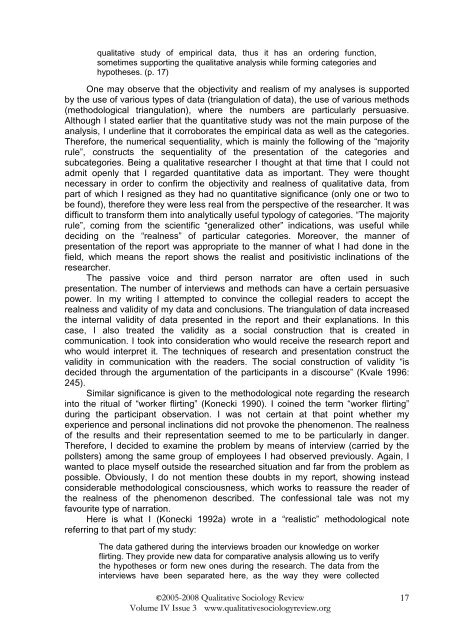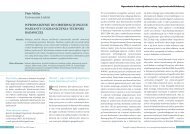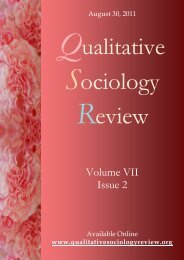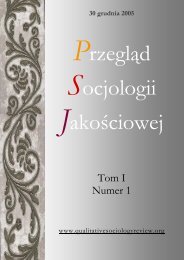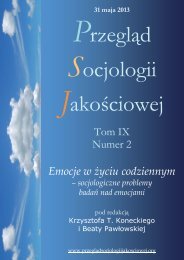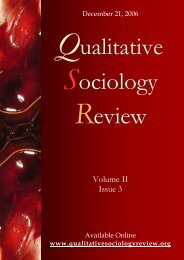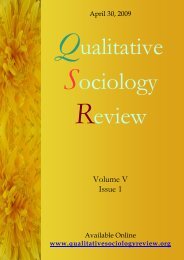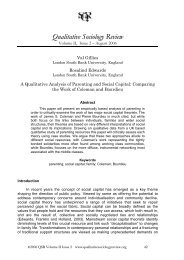volume IV is 3 - Qualitative Sociology Review
volume IV is 3 - Qualitative Sociology Review
volume IV is 3 - Qualitative Sociology Review
You also want an ePaper? Increase the reach of your titles
YUMPU automatically turns print PDFs into web optimized ePapers that Google loves.
qualitative study of empirical data, thus it has an ordering function,<br />
sometimes supporting the qualitative analys<strong>is</strong> while forming categories and<br />
hypotheses. (p. 17)<br />
One may observe that the objectivity and real<strong>is</strong>m of my analyses <strong>is</strong> supported<br />
by the use of various types of data (triangulation of data), the use of various methods<br />
(methodological triangulation), where the numbers are particularly persuasive.<br />
Although I stated earlier that the quantitative study was not the main purpose of the<br />
analys<strong>is</strong>, I underline that it corroborates the empirical data as well as the categories.<br />
Therefore, the numerical sequentiality, which <strong>is</strong> mainly the following of the “majority<br />
rule”, constructs the sequentiality of the presentation of the categories and<br />
subcategories. Being a qualitative researcher I thought at that time that I could not<br />
admit openly that I regarded quantitative data as important. They were thought<br />
necessary in order to confirm the objectivity and realness of qualitative data, from<br />
part of which I resigned as they had no quantitative significance (only one or two to<br />
be found), therefore they were less real from the perspective of the researcher. It was<br />
difficult to transform them into analytically useful typology of categories. “The majority<br />
rule”, coming from the scientific “generalized other” indications, was useful while<br />
deciding on the “realness” of particular categories. Moreover, the manner of<br />
presentation of the report was appropriate to the manner of what I had done in the<br />
field, which means the report shows the real<strong>is</strong>t and positiv<strong>is</strong>tic inclinations of the<br />
researcher.<br />
The passive voice and third person narrator are often used in such<br />
presentation. The number of interviews and methods can have a certain persuasive<br />
power. In my writing I attempted to convince the collegial readers to accept the<br />
realness and validity of my data and conclusions. The triangulation of data increased<br />
the internal validity of data presented in the report and their explanations. In th<strong>is</strong><br />
case, I also treated the validity as a social construction that <strong>is</strong> created in<br />
communication. I took into consideration who would receive the research report and<br />
who would interpret it. The techniques of research and presentation construct the<br />
validity in communication with the readers. The social construction of validity “<strong>is</strong><br />
decided through the argumentation of the participants in a d<strong>is</strong>course” (Kvale 1996:<br />
245).<br />
Similar significance <strong>is</strong> given to the methodological note regarding the research<br />
into the ritual of “worker flirting” (Konecki 1990). I coined the term “worker flirting”<br />
during the participant observation. I was not certain at that point whether my<br />
experience and personal inclinations did not provoke the phenomenon. The realness<br />
of the results and their representation seemed to me to be particularly in danger.<br />
Therefore, I decided to examine the problem by means of interview (carried by the<br />
pollsters) among the same group of employees I had observed previously. Again, I<br />
wanted to place myself outside the researched situation and far from the problem as<br />
possible. Obviously, I do not mention these doubts in my report, showing instead<br />
considerable methodological consciousness, which works to reassure the reader of<br />
the realness of the phenomenon described. The confessional tale was not my<br />
favourite type of narration.<br />
Here <strong>is</strong> what I (Konecki 1992a) wrote in a “real<strong>is</strong>tic” methodological note<br />
referring to that part of my study:<br />
The data gathered during the interviews broaden our knowledge on worker<br />
flirting. They provide new data for comparative analys<strong>is</strong> allowing us to verify<br />
the hypotheses or form new ones during the research. The data from the<br />
interviews have been separated here, as the way they were collected<br />
©2005-2008 <strong>Qualitative</strong> <strong>Sociology</strong> <strong>Review</strong><br />
Volume <strong>IV</strong> Issue 3 www.qualitativesociologyreview.org<br />
17


